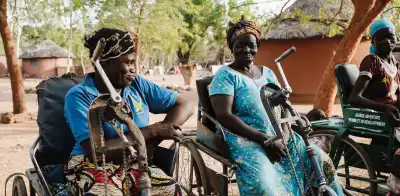Summary
After a few challenging years, nonprofit Emancipet is in the initial phases of implementing OKRs to improve employee engagement, hit ambitious fundraising targets, and drive expansion to make veterinary care affordable and accessible to pet owners who’ve been economically excluded.
Implementing OKRs Together
When Amy Mills, CEO of Emancipet, and her senior team found themselves at a training for nonprofit boards, they came away committed to be far bolder in the way they set goals. It was already a daunting mission: making veterinary care affordable and accessible to low-income families. In nine years, Emancipet had built low-cost veterinary hospitals in vulnerable communities and trained people who are not veterinary technicians into their roles, offered services at low rates, without turning away clients who couldn’t pay. They had put every penny back into the clinic network, opening one new clinic a year and, as of 2021, serving 230,000 visitors. The problem was, while that’s not nothing, it’s not nearly enough to close the gap.
“We know there is this huge gap in access to veterinary care in the United States — we estimated it’s about 50 million animals,” says Mills,” So we’ve got a lot of animals who are dearly beloved members of their families unable to get the care that they need. That is what we exist to solve.” That’s why in 2020, they decided to up the ante to “by 2028 everyone in the United States will have access to veterinary care they can afford.”
We all know what came next. When the pandemic hit in March of that year, Emancipet went into crisis-management mode. The bold goal went on the back burner.
By December 2021, staff felt burned out, and the whole veterinary care industry was facing a workforce crisis. That’s when Mills decided it was time to revive the big idea. “You know, nobody who comes to work at Emancipet comes to work for the highest salary,” says Mills. “You come to work because you’re actually trying to change the world.”
Energizing the team by going bigger
But Mills knew that a team couldn’t go from burned out to big audacious goal without a realistic plan. “I started doing research, reading every book I could, sketched out this outline, and went to our then CFO — she’s brilliant.” Whereupon the two had a conversation to make Abbott and Costello proud: “I said, ‘Mona, this is what I’m thinking.’ And Mona said, ‘Oh, so you just want OKRs?’ And I was like, ‘I don’t know what an OKR is.’”
Turns out Mona had used them in her prior job and suggested Mills read Measure What Matters. “I texted her: ‘This is exactly what I’ve been looking for my whole life,’” says Mills, who felt that the transparency and organization-wide adoption that’s built into the OKR process was key to revive a team that had spent months just trying to keep the doors open.
“I wanted it to be something that our entire senior team could feel like they had expertise on,” says Mills. “And I love that all of these resources are available so that we could learn together how to use the OKRs, rather than top down.”
At that point, Mills, her senior staff, and the board had already agreed on four areas that they knew they needed to address to get to the bold goal:
- Focus on the well-being of their veterinary staff who were in danger of burning out.
- Open two new clinics.
- Rethink fundraising goals.
- Lean into a potential large partnership to scale their work.
In the senior staff’s first discussions, the team was talking about why those four areas were truly the most important. Before anyone went down a rabbit hole, Mills stopped the meeting and asked her team to go read Measure What Matters book and the website. “Get familiar with this,” she told them, “and then we’re going to meet in two weeks and create the Objectives together.” OKRs gave Mills a way to frame Emancipet’s big audacious goal for its pet clients, while also telegraphing the value of its human staff.

Setting and achieving shared goals
At the following get-together, the group narrowed the meeting’s focus to crafting one Objective for Q1 in each of the four areas. They then asked each other: What would some Key Results look like?
It got difficult, says Mills. “One big thing to note is our team really struggled with the difference between KPIs and KRs. We are a very KPI-driven organization. We have a weekly report that everybody looks at across the entire organization. It took us a while to understand that we weren’t talking about KPIs — which measure the health of the organization on a day-to-day operational basis. We were talking about transformations. Each of these describes a change we want to make in the organization, not a description of the things we have to achieve every single day in order to just maintain.”
It might seem counterintuitive, but creating space to describe and measure a bolder future energized the team. “What I love about this OKR process,” says Mills, “is that it’s a way of saying ‘We’re not just hanging in — we really are trying to change the world.’”
Setting goals collaboratively also transformed the way the team approached long-standing challenges. Key among them? Fundraising. For every nonprofit, it’s a bedrock expectation to have to raise a certain amount during the year, to increase the contributions over last year. Focusing on the big, bold goal was going to require big leaps beyond what they had been able to raise in the past. How should they organize that effort?
The team’s first version involved a very traditional breakdown: Take the total fundraising target for Q1 and divide it up by channel. “We’re going to raise $100,000 from direct mail, and $200,000 from major donor work, and $200,000 from events,” says Mills. But in discussions, the team felt it was too specific. Next, they proposed dividing fundraising goals by region. But that meant pitting the fundraising staff in Houston against the staff in Philadelphia.
It became clear that in order to succeed, the fundraising team could no longer be siloed in pursuing the enormous increase. “I could have easily made a case that the head of the fundraising should have more say in the $5 million for our future,” says Mills, “But that would have been counterproductive to one of the things I was trying to achieve, which is getting all of us — whether the head of accounting or the head of HR — to see how we’re all responsible for these things. I saw the OKRs as a way to bring the senior leadership team of the organization back together, instead of seeing themselves each as the leader of their own departments.”
In the end, the team chose to keep their fundraising target as a shared, organization-wide goal. “Everyone contributes to that,” Mills says, “So asking the client, the staff, asking for a donation in our clinic, they contribute to that.” The OKR process had helped them achieve something elusive: buy-in across departmental silos.
OKRs bring a team together
The team repeated the process for the other areas — opening clinics, staff engagement, and partnerships. In addition to the meetings where staff hashed out issues, they also kept a Google doc to keep the conversations going. “Not everybody is an extrovert and comfortable sharing out loud,” says Mills, “Having the Google doc where everybody could write their own thoughts afterwards was where their richest contributions came from. People had a little bit more time to just think about it and see what somebody else had written.”
Mills synthesized the comments into a draft set of OKRs to bring back to everyone and ask, “All right, what about these? Which ones do we love, feel like are really ours, and which ones still need work?” They went through a few rounds of iteration before a final meeting to affirm that, “Yes, these feel exactly right.”
Narrowing down to four goals was a major accomplishment, and it didn’t come easily to a team writing OKRs for the first time. “This group wants 15 Objectives, not four Objectives,” said B.J. Rogers, chief learning officer. “The OKRs impose discipline that’s been valuable and will prove to our benefit along the way.”
Like every nonprofit, Emancipet has big goals and limited resources. The OKRs clarified that if a request came to the CFO for resources that didn’t align with one of the four Objectives, it wasn’t going to get allocations in the budget. “That was a big eye opener for a lot of people,” says Mills. “I think that was a big shift for the team.” The collaboration required to settle on the four Objectives meant that even when surprised by the change, the transparency of the process meant the team was able to understand the reason for the change.
The process of co-creation helps everyone move forward as a team, says Rogers, “because literally all of us have some hand or stake in each of the Objectives.” Not to mention, how OKRs help advance the team’s audacious goal — ensuring every beloved pet in the United States has the veterinary care they need, at a price their owner can afford.



